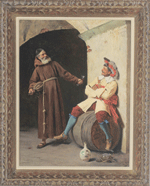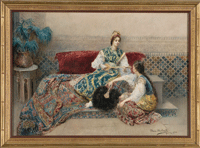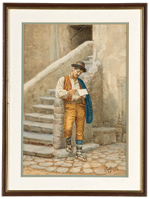|
Cowan's Corner
Tourist Tokens Can Bring in Big Coin
By Wes Cowan
If you have ever travelled
to Florence, Venice or Rome,
then you must have noticed
a charming street side artist
or two, painting wonderful
watercolors of the Ponte
Vecchio or Piazza San Marco.
You likely got whisked
away by the sunny day and
succumbed to a seemingly
outrageous price for one of
these little gems. As it turns
out, these “mementos” from
only a century ago are very
desirable in today’s market.
For several centuries
now, collectors have been
drawn to the “Italian School” of art. This comes long after
the Renaissance masters
Michelangelo and Raphael
graced churches and cathedrals
with their masterpieces and
after Caravaggio and Bernini
changed the perception of
art with twisting, climactic
compositions.
In the market of antiques
and fine art, we refer to a
new “Italian School” of
painting as turn-of-thecentury
watercolors and oil
paintings with subjects of
everyday life. The majority
of these artists remain obscure. In most cases, scarce
biographical information can
be found. Some attended fine
art schools, and others have
no documented background.
We do know that from
approximately 1880-1920,
there was an enormous output
of works by these Italian
artists.
Several noticeable trends
are consistent in the paintings
of our Italian School friends.
Subject matter is typically that
of daily life: men drinking,
flirtatious scenes, discreet
conversations, a shepherd
or shepherdess. They were
selling their paintings, in many cases, to foreigners who
were enamored with Italian
culture, just as we would buy
a painting from a street artist
in Italy today.
Italian School artists liked
to sign their works in a similar
manner, using an expressive,
cursive form. These paintings
were usually dated and also
included the artist’s town of
origin, such as “Roma” or
“Firenze”. Anyone who has
watched an Italian soccer
game is certainly familiar
with Italians’ sense of
regional pride. The paintings
were typically executed in
watercolor, a less expensive medium and one that afforded
faster and higher production.
Today, an Italian School
painting is very desirable
and can garner hefty prices
at auction or galleries. Oil
paintings are considered a
loftier medium than watercolor
because they rarely appear
on the market. Orientalist
subject matter seems to pique
collectors’ more than any
other subject matter. Italian
School paintings consistently
sell in the low thousands,
while oils and Orientalist
works can command upwards
of five figures.
Many of these paintings are surfacing all over the
world because they were
purchased by the average
tourist a century ago and
brought back to all corners of
the world.
 About the author: Wes Cowan is founder and
owner of Cowan’s Auctions,
Inc. in Cincinnati, Ohio. An
internationally recognized
expert in historic Americana,
Wes stars in the PBS television
series History Detectives
and is a featured appraiser
on Antiques Roadshow. He
can be reached via email at
info@cowans.com. Research
by Graydon Sikes . About the author: Wes Cowan is founder and
owner of Cowan’s Auctions,
Inc. in Cincinnati, Ohio. An
internationally recognized
expert in historic Americana,
Wes stars in the PBS television
series History Detectives
and is a featured appraiser
on Antiques Roadshow. He
can be reached via email at
info@cowans.com. Research
by Graydon Sikes .
|

An oil painting by Arnaldo Tamburini that is
estimated to sell for $2,000- $3,000.

This Orientalist scene by Maria Marinetti sold for $10,500.

R. Moretti, an unknown Italian School artist, $900.
|